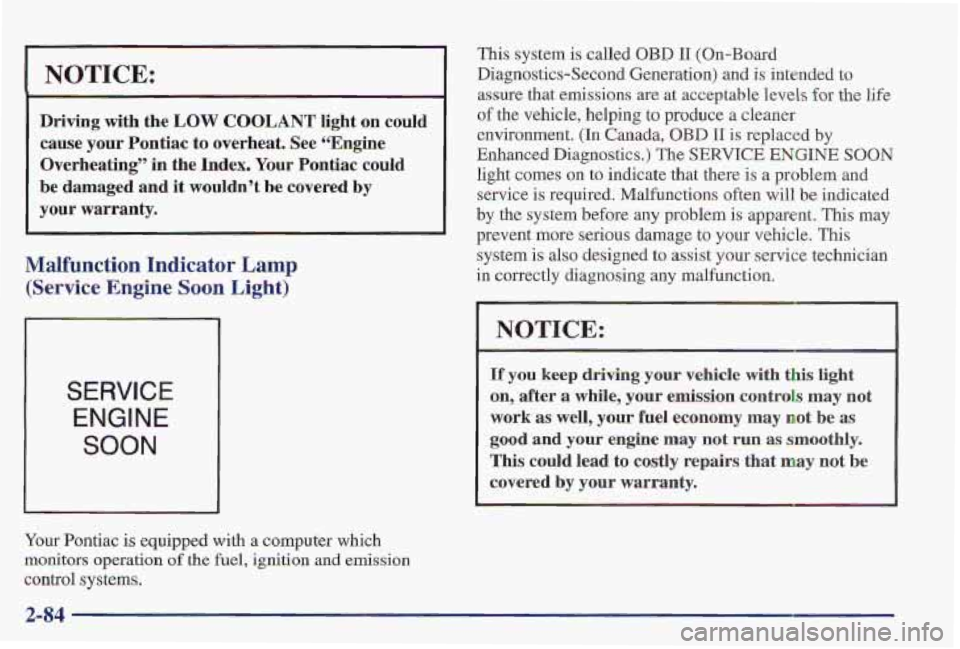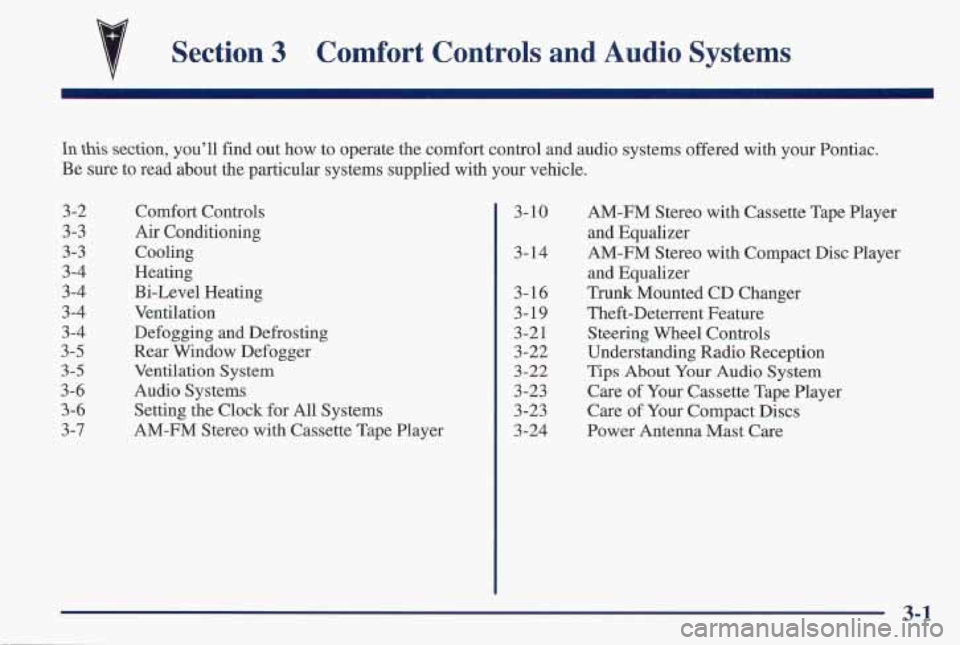PONTIAC FIREBIRD 1997 Owners Manual
Manufacturer: PONTIAC, Model Year: 1997, Model line: FIREBIRD, Model: PONTIAC FIREBIRD 1997Pages: 410, PDF Size: 19.2 MB
Page 131 of 410

The traction control system warning light may come on
for the following reasons:
If you turn the system off by pressing the switch
located at the front
of the console the warning light
will come on and stay on and the light on the switch
will
go out. To turn the system back on, press the
switch again. The warning light should go off.
(See “Traction Control System” in the Index
for more information.)
If the temperature of the throttle control b’egins to
rise, the system will turn off and the warning light
will come
on until the system cools down. The
system does this to prevent damage from
overheating.
If the traction control system warning light comes on
and stays on for an extended period
of time when the
system
is turned on, your vehicle needs service.
Low Traction Light
When your anti-lock system
is adjusting brake pressure
to help avoid
a braking skid,
this light will come on.
LOW
TRAC
If you have the traction control system, this light will
also come
on when the system is limiting wheel spin.
Slippery road conditions may exist if the low traction
light comes on,
so adjust your driving accordingly. The
light will stay on for a few seconds after the anti-lock
system stops a’djusting brake pressure or the traction
control system stops limiting wheel spin.
The low traction
light also comes on briefly when you
turn the ignition
key to RUN. If the light doesn’t come
on then, have
it fixed so it will be there to tell you when
the anti-lock brake system or traction control system
is active.
2-82
Page 132 of 410

Engine Coolant Temperature Gage
This gage shows the engine
coolant temperature.
If the
gage pointer moves into the
red area, your engine is too
hot! It means that your
engine coolant has
overheated.
Low Coolant Light (VS Engine)
This warning light should
come on while you are
starting your engine.
If the
light doesn’t
come on, have
it repaired.
If you have been operating your vehicle under normal
driving conditions, you should pull off the road, stop
your vehicle and turn off the engine as soon as possible.
In “Problems
on the Road,” this manual shows what to
do. See “Engine Overheating” in the Index. Your
Firebird is equipped with
a LOW COOLANT
indicator which is designed to detect when the coolant
level drops below set limits. If the low coolant level
sensor (on the radiator) drops while the engine is
running,
the LOW COOLANT indicator will light and
remain lit until the ignition switch
is turned to the OFF
position. Check coolant level and add coolant as needed.
The LOW COOLANT light might stay on after filling
the radiator. Turn the ignition switch to the
OFF
position, then restart the engine to verify that the LOW
COOLANT light goes out. See “Engine Coolant” in
the Index.
2-83
Page 133 of 410

NOTICE:
Driving with the LOW COOLANT light on could
cause your Pontiac
to overheat. See 66Engine
Overheating”
in the Index. Your Pontlac could
be damaged and
it wou1dn”t be covered by
your warranty.
Malfunction Indicator Lamp
(Service Engine Soon Light)
SERVICE
ENGINE
SOON
Your Pontiac is equipped with a computer which
monitors operation
of the fuel. ignition and emission
control systems. This
system is called
OBD I1 (On-Board
Diagnostics-Second Generation) and is intended to
assure that emissions are at acceptable levels
for the life
of the vehicle, helping to produce a cleaner
environment.
(In Canada, OBD 11 is replaced by
Enhanced Diagnostics.) The SERVICE ENGINE SOON
light comes on to indicate that there is a problem and
service
is required. Malfunctions often will be indicated
by the system before any problem is apparent. This may
prevent more serious damage
to your vehicle. This
system is also designed to assist your service technician
in correctly diagnosing any malfunction.
NOTICE:
If you keep driving your vehicle with this light
on, after
a while, your emission controls may not
work as well, your fuel economy may not be as
good and your engine may not run as smoothly.
This could lead to costly repairs that may not be
covered by your warranty,
2-84
Page 134 of 410

This light should come on, as a check to show you it is
working, when the ignition is on and the engine is not
running. If the light doesn’t come on, have it repaired.
This light will also come on during a malfunction in one
of two ways:
0
0
Light Flashing -- A misfire condition has been
detected. A misfire increases vehicle emissions and
may damage the emission control system on your
vehicle. Dealer or qualified service center diagnosis
and service
is required.
Light On Steady -- An emission control system
malfunction has been detected on your vehicle.
Dealer or qualified service center diagnosis and
service may be required.
If the Light Is Flashing
The following may prevent more serious damage to
your vehicle:
0 Reducing vehicle speed.
0 Avoiding hard accelerations.
0 Avoiding steep uphill grades.
0 If you are towing a trailer, reduce the amount of
cargo being hauled as soon as it is possible.
If the light stops flashing and remains on steady, see “If
the Light
Is On Steady” following.
If the light continues to flash, when it is safe to do so,
stop the vehicle. Find a safe place to park your vehicle.
Turn the key off, wait at least 10 seconds and restart the
engine.
If the light remains on steady, see “If the Light
Is On Steady” following. If the light is still flashing,
follow the previous steps, and drive the vehicle to your
dealer or qualified service center for service.
2-85
Page 135 of 410

If the Light Is On Steady Have you recently changed brands of fuel?
You may be able to correct the emission system
malfunction by considering the following:
Did you recently put fuel into your vehicle?
If
so, reinstall the fuel cap, making sure to fully install
the cap, The diagnostic system can determine if the fuel
cap has been left
off or improperly installed. A loose or
missing fuel cap will allow fuel
to evaporate into the
atmosphere.
A few driving trips with the cap properly
installed should turn the light off.
Did you just drive through
a deep puddle of water?
If so, your electrical system may be wet. The condition
will usually be corrected when the electrical system
dries out. A few driving trips should turn the light
off,
Are you low on fuel?
As your engine starts to run
out of fuel, your engine may
not run as efficiently
as designed since small amounts of
air are sucked into the fuel line causing a misfire. The
system can detect
this. Adding fuel should correct this
condition. Make sure to install
the fuel cap properly. It
will take a few driving trips to turn the light off. If
so, be sure to fuel your
vehicle with quality fuel (see
“Fuel” in the Index). Poor fuel quality will cause your
engine
not to run as efficiently as designed. You may
notice this as stalling after start-up, stalling when you
put the vehicle into gear, misfiring, hesitation on
acceleration or stumbling on acceleration. (These
conditions may
go away once the engine is warmed up.)
This will be detected by the system and cause the light
to turn on.
If you experience one or more
of these conditions,
change the fuel brand
you use. It will require at least one
full tank of the proper fuel to turn the light off.
If none
of the above steps have made the light turn off,
have your dealer or qualified service center check the
vehicle. Your dealer has the proper test equipment
and
diagnostic tools to fix any mechanical or electrical
problems that
may have developed.
2-86
Page 136 of 410

Engine Oil Pressure Gage
/
120
\‘O ii
0
V6 Engine VS Engine
One of these gages may tell you there could be a
problem with your engine oil pressure.
The engine oil pressure gage shows the engine oil
pressure in psi (pounds per square inch) in the United
States, or kPa (kilopascals) in Canada, when the engine
is running. Oil pressure should be
20 to 80 psi (140 to
550 kPa). On the 3800 engine the oil pressure should be
between
20 and 120 psi (140 to 827 kPa). It may vary
with engine speed, outside temperature and oil viscosity,
but readings above the red area show the normal
operating range. Readings in the red area tell you that the
engine is low
on oil, or that you might have some
other
oil problem. See “Engine Oil” in the Index.
Don’t keep driving if the oil pressure is low. If
you do, your engine can become so hot that it
catches fire. You or others could be burned.
Check your oil as soon
as possible and have your
vehicle serviced.
I NOTICE:
Damage to your engine from neglected oil
problems can be costly and
is not covered by
your warranty.
2-87
Page 137 of 410

Low Oil Light
LOW
OIL
Your vehicle is equipped
with an oil level monitoring
system. When you start
your engine, the warning
light will come on briefly. If
the light doesn’t come on,
have it repaired.
If the light stays on after starting your engine, your
engine
oil level may be too low. You may need to add
oil. See “Engine Oil” in the Index.
NOTICE:
The oil level monitoring system only checks the
oil level when
you are starting your engine. It
does not keep monitoring the level once
your
engine is running. Also, the oil level check only
works when the engine has been turned off long
enough for the oil to drain back into the oil pan.
2-88
Page 138 of 410

Check Gages Light When the gage pointer first indicates EMPTY (E) you
need to get more right away.
CHECK
GAGES
Fuel Gage
I
This warning light will
come on briefly when
YOU
are starting the engine. If
the light comes on and
stays on while you are
driving, check your gages
to see if they are in the
warning areas.
Your fuel gage shows about
how much fuel is in
your
tank. The gage works only
when the ignition switch is
in the RUN position. Here are four concerns some owners have had
about the
fuel gage. All these situations are normal and do not
indicate that anything
is wrong with the fuel gage.
0
0
0
0
At the gas station, the gas pump shuts off before the
gage reads FULL
(F).
It takes more (or less) gas to fill up than the gage
reads. For example, the gage reads
1/2 full, but it
took more (or less) than half
of the tank's capacity to
fill it.
The gage moves
a little when you turn, stop or
speed up.
When you turn the engine off, the gage doesn't go
back to
EMPTY (E).
Page 139 of 410

2-90
Page 140 of 410

Section 3 Comfort Controls and Audio Systems
In this section, you’ll find out how to operate the comfort control and audio systems offered with your Pontiac.
Be sure to read about the particular systems supplied with your vehicle.
3-2
3-3
3-3
3-4
3-4
3-4
3
-4
3-5
3-5
3-6
3 -6
3-7
Comfort Controls
Air Conditioning
Cooling
Heating
Bi-Level Heating
Ventilation
Defogging and Defrosting
Rear Window Defogger
Ventilation System
Audio Systems Setting the Clock
for All Systems
AM-FM Stereo with Cassette Tape Player
3-10
3- 14
3-16
3-19
3-2
1
3-22
3-22
3-23
3-23
3-24 AM-FM Stereo with Cassette
Tape Player
and Equalizer
AM-FM Stereo with Compact Disc Player
and Equalizer
Trunk Mounted
CD Changer
Theft-Deterrent Feature
Steering Wheel Controls
Understanding Radio Reception
Tips About Your Audio System
Care
of Your Cassette Tape Player
Care
of Your Compact Discs
Power Antenna Mast Care
3-1